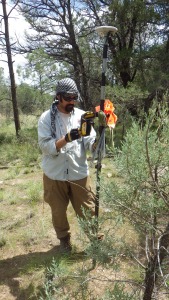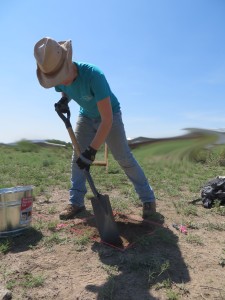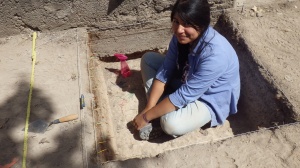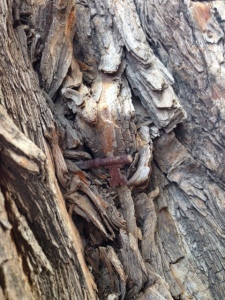Written by Erin Rodriguez, FODAAP co-director and geoarchaeologist
If you’ve ever stopped by FODAAP excavations, you may have seen something like this:
In this photo I am taking a micromorphology sample from a shovel test pit excavated during our 2014 season. As a geoarchaeologist, I use geological methods to study archaeological issues – understanding the human past through material remains. In this case those material remains are the actual sediments and soils that we as archaeologists excavate in order to recover artifacts, map architecture, and analyze the spatial contexts of archaeological materials. These sediments are fundamentally important as they allow us to understand the context of recovered materials which is the basis of scientific archaeological investigations. Further, human activity (as well as animal, plant, and environmental actions and processes) leaves traces on sediments and soils that can be reconstructed through detailed and careful analysis.

The primarily methods of geoarchaeological analysis that I use as part of the Fort Davis Archaeological Project are microscale analyses looking at microscopic physical relationships between sediment features as well as chemical aspects of soils such as organic matter content, pH, and phosphate and heavy metal concentrations. In the image at the beginning of this post I am taking a micromorphology sample – an undisturbed block of sediment which will be impregnated with resin and cut into ultrathin microscope slides so I can analyze the spatial relationships between sediment components. This allows me to better understand relationships between features observed in the field, to identify microscopic sediment components that provide new information about archaeological deposits, and to reconstruct the processes which create and effect archaeological sites.
The image above shows how a slide from a micromorphology sample relates to a profile from a unit excavated by FODAAP in 2014. This particular slide showed the presence of localized burning of a trash deposit which was not identified during excavation. The burning is only in one slide from part of this excavation unit, so it may have been an intentional burn as part of maintenance or cleaning of the dump. This slide also contains microremains from artifacts found in the trash deposit (metal fragments, glass shards, eggshell) as well as evidence of insect activity.

Micromorphology, as well as other microscale geoarchaeological analyses, has the potential to provide essential information about human activities, processes which create archaeological sites, and factors which can effect sites over time such as erosion, animal activity, and other factors. While as not commonly represented in archaeological explanations, geoarchaeological data enriches our interpretations of the past and enables us to better understand the lives and actions of past people.






